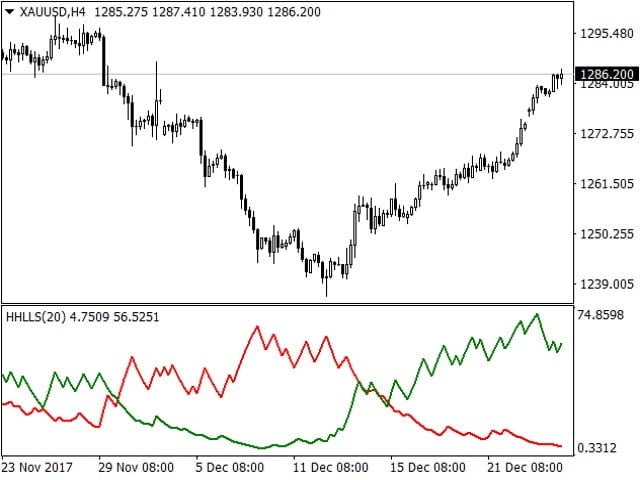Momentum indicator based on the idea of Vitaly Apirin. Allows you to determine the direction of the trend. If the green line is higher than the red line, the trend is upward; if the opposite is true, it is downward.
The indicator performs two separate calculations: the stochastic of rising highs (higher highs, HH) and the stochastic of falling lows (lower lows, LL), which together make up the HHLLs indicator. Vitaly Apirin uses his ideas to study the stochastic oscillator and the Williams percentage range, which form a new indicator based on consecutive highs and lows.
HHLLs (higher high, lower low stochastic) allows you to detect emerging trends, determine correction periods, and predict reversals. As with many other indicators, HHLLs signals can also be generated by searching for discrepancies and intersections. Since HHLLs is an oscillator, it can also be used to determine overbought and oversoldlevels .
HHLLs is based on exponentially smoothed ratios of price highs to the highs and lows of previous periods, as well as exponentially smoothed ratios of price lows to the highs and lows of previous periods. Two stochastic lines (HHs and LLs) are created, the intersections and divergences of which with the base prices indicate reversals and continuation of the trend. In the screenshot below, they are displayed as green and red lines, respectively.
[spoiler title=”Read More…”]
- Indicator Period: The number of bars used to calculate the indicator. Suitable values are 5-50. Typical value: 20.
- Calculated Bars: The number of bars on which the indicator is calculated. The higher this number, the longer the indicator is displayed. It is usually sufficient to use the last 1000 bars. Reduce this value to increase the time frame switching speed on the chart. The parameter value cannot be lower than Indicator Period.
- Moving Average method – the moving average method for calculations. Values: Simple, Exponential, Smoothed, Linear Weighted.
[/spoiler]





